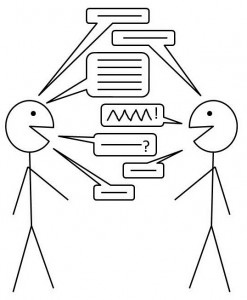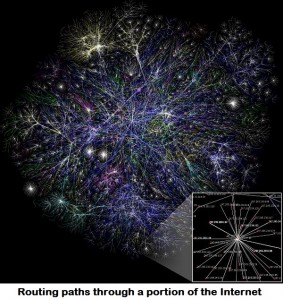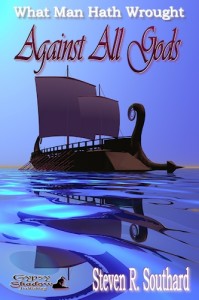Dialogue through verbal speech is as important to your fictional characters as it is to us flesh-and-blood folks, though for somewhat different reasons. For both fictional and real people, speaking is the most common form of communication, and communication is, of course, not only vital but is something we humans do a lot.
However, real people engage in spoken dialogue for only a few reasons, and among them are:
- to inform
- to persuade
- to establish a relationship
- to argue
- to direct or command
 When our fictional characters talk, it is for these reasons, too, but also several more. This is due to the difference in their situation. For example, we often speak ‘off the cuff’ without much preparation or forethought; characters never do that, though they seem to. Characters only exist due to the efforts of an entity called a ‘writer,’ of whom they are unaware. They exist solely for the benefit and enjoyment of another entity called a ‘reader,’ of whom they are also unaware. So dialogue between characters also serves these purposes:
When our fictional characters talk, it is for these reasons, too, but also several more. This is due to the difference in their situation. For example, we often speak ‘off the cuff’ without much preparation or forethought; characters never do that, though they seem to. Characters only exist due to the efforts of an entity called a ‘writer,’ of whom they are unaware. They exist solely for the benefit and enjoyment of another entity called a ‘reader,’ of whom they are also unaware. So dialogue between characters also serves these purposes:
- to set the scene; that is, help the reader ‘see’ the scene
- to establish a character’s personality
- to advance the plot by introducing or heightening the conflict
- to create suspense or add tension
- to remind the reader of previous events or characters
- to foreshadow future events
- to provide easy-to-read ‘white space’ in between narration paragraphs
Most of the time, fictional dialogue is accomplishing many of these functions at once. That might seem a daunting task for the beginning writer, and you may be wondering how you’ll ever write dialogue that does so much. As an author not too far removed from beginner status, all I can say is, I’m told the task gets easier with practice, like any good habit.
Now that we’ve covered the differences in purpose, let’s cover the differences in form between real and fictional dialogue.
- In the first place, fictional dialogue is less dull. As much as we try not to be dull in real life, much of our conversation is, frankly, boring. Fiction can’t afford to be dull, so leave out all the ‘ums’ and ‘ahs’ of real speech. Cast out all the little pleasantries like ‘how are you doing?’ ‘fine,’ etc. Ever notice fictional characters rarely say ‘hello’ or ‘goodbye?’ Now you know why.
- Fictional characters shouldn’t have as strong an accent as real people, at least as it’s depicted in written dialogue. Whether your character is from the deep South, New England, or speaks English with a strong foreign accent, don’t attempt to replicate every word by spelling it as your character would pronounce it. Just do that with a couple of words per sentence at most. Your readers’ imaginations will do the rest, and you don’t want to make it difficult for them to decipher your prose.
And that’s it. In other words, fictional dialogue isn’t too different from everyday speaking, at least on the surface. If it were significantly different, readers wouldn’t find it believable. It’s only beneath the surface where fictional dialogue serves purposes beyond what’s going on in real conversation. Here are three links to great articles giving helpful guidance about fictional dialogue: here, here, and here.
“Hope you enjoyed my blog entry on how dialogue is different from plain old yakking. Feel free to leave a comment whether you agree or disagree,” said—
Poseidon’s Scribe








